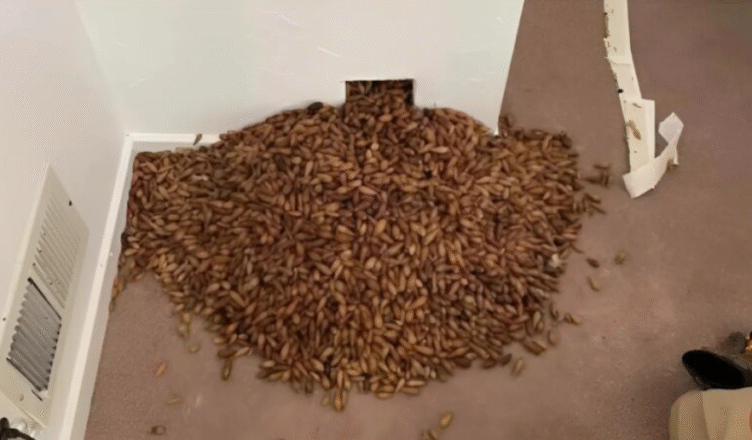I’ve always considered my home to be a silent companion—a place where the only sounds were the ticking of a clock or the creak of a floorboard. But one winter, something changed. The quiet began to fracture. At first, it was faint—a soft tapping, a faint rustle, an almost imperceptible thump behind the walls. I brushed it off as old pipes or settling wood. Houses have quirks, after all. But as days turned into weeks, the noises grew more deliberate, almost rhythmic, as if some hidden life was pulsing within the plaster.

Some nights, lying in bed, I could swear the walls were breathing. It wasn’t the sound of wind or rain. It felt… intentional. I told myself I was tired, overworked, imagining things. But then I began to see odd shadows ripple where no light should move, as if something inside the wall itself was alive and shifting
Still, I didn’t act immediately. Part of me was curious, almost enchanted by the mystery. But curiosity has a strange way of curdling into unease, and before long, I found myself straining to listen in the dark, wondering what shared my home.
The turning point came on a gray afternoon when I noticed a faint drip-drip from the ceiling. My first thought was water damage. My second—pests. Neither was comforting. I called a local pest control service, hoping for quick reassurance. Instead, the inspector, a calm man with decades of experience, listened intently to the walls, frowned, and told me we’d need to open a section.

I braced myself for the worst—nests of mice, perhaps termites, maybe even mold spreading unseen. He took a utility knife and made a careful incision. The wall gave way with a soft crack… and then something extraordinary happened.
From the narrow opening poured a river of acorns.
Not a few scattered seeds, but hundreds—then thousands—streaming onto the floor in a warm, earthy cascade. They rolled across the hardwood like marbles, clinking softly against each other. We both stood frozen for a moment, as though the house itself had just emptied its pockets.
When the flow slowed, we peered inside. More acorns were packed tightly between the studs and insulation, layer upon layer, stretching up into the ceiling. The inspector whistled low. “I’ve seen a lot,” he said, “but nothing like this.”

In total, we removed over seven hundred pounds—more than three hundred kilograms—of perfectly preserved acorns, all stored with meticulous care. And the culprit? Not a person, not a squirrel, but a bird—a striking black-and-white Acorn Woodpecker, as the expert later explained.
For years, unseen, it had been slipping into small gaps near the eaves and stashing its winter pantry inside my home. Every acorn had been placed deliberately, wedged so snugly it would never fall out until we opened the wall.
I should have been angry. After all, the repairs would be costly, and my home had been turned into a giant granary without my consent. But as I stared at that treasure trove of nature’s currency, something in me shifted. This wasn’t destruction—it was creation. It was foresight, dedication, and the instinct to survive.
I thought about those nights I’d lain awake, feeling uneasy. All that time, the bird had been at work, ferrying acorn after acorn, building its store with tireless precision. I had feared the unknown. But the unknown, it turned out, had been nothing more than a small creature trying to prepare for the cold.
We gathered the acorns carefully, bagging them until the living room looked like a woodland market. I couldn’t bring myself to discard them. Instead, we carried them to the edge of the nearby forest, where they could serve their true purpose—feeding animals through the winter.
When the repairs were done, the house looked unchanged from the outside. But to me, it felt different. I had been given a strange, unexpected gift: the reminder that even the smallest lives carry wisdom. That bird, without meaning to, had taught me about resourcefulness, patience, and the quiet persistence of nature.
Now, when wind slips through the trees and whistles faintly against the siding, I pause and listen. Maybe it’s the same woodpecker, finding a new place to tuck away its treasures. Or maybe it’s another bird, continuing an old tradition. Either way, I no longer feel the need to shut it out.

People often ask about the “mystery” in my walls. I tell them the truth—not the dry, technical version, but the part that matters. That once, a wild neighbor moved in, not with noise or trouble, but with a plan. And that plan—though it took over my home for a while—ended up leaving me with a deeper respect for the world beyond my doors.
Because sometimes, the strangest disturbances aren’t warnings to be afraid. They’re invitations to pay attention.
And whenever I think of that river of acorns, I can’t help but smile. The house may be mine, but for a time, it was shared—with a tiny, determined landlord who knew the value of saving for the winter.
